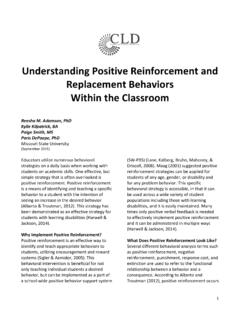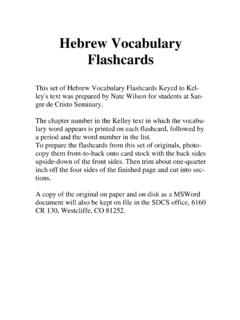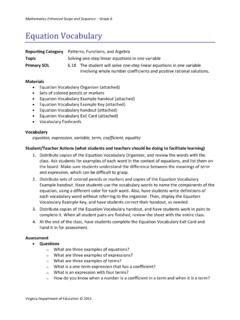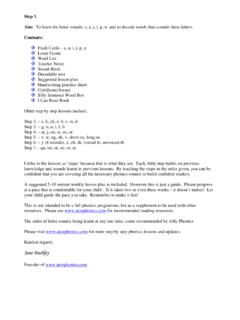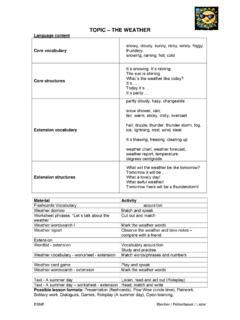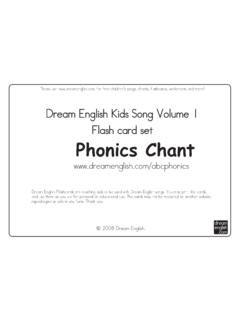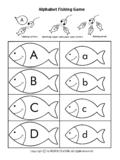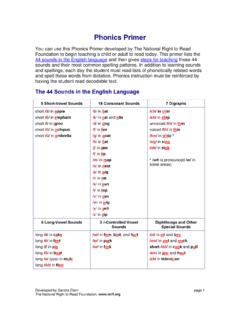Transcription of Strategiesand)Interventionsto)Support) Studentswith ...
1 1 Strategies and Interventions to support Students with Mathematics Disabilities Brittany L. Hott, PhD Laura Isbell, PhD Texas A&M University- Commerce Teresa Oettinger Montani, EdD Fairleigh Dickinson University (December 2014) In the absence of intensive instruction and intervention, students with mathematics difficulties and disabilities lag significantly behind their peers (Jitendra et al., 2013; Sayeski & Paulsen, 2010). Conservative estimates indicate that 25% to 35% of students struggle with mathematics knowledge and application skills in general education classrooms, indicating the presence of mathematics difficulty (Mazzocco, 2007).
2 Additionally, 5% to 8% of all school- age students have such significant deficits that impact their ability to solve computation and/or application problems that they require special education services (Geary, 2004). This InfoSheet provides an overview of strategies and resources to support students with, or at- risk for, mathematics learning disabilities. Common Core Mathematics Standards With the current emphasis on the Common Core State Standards (CCSS; National Governors Association Center for Best Practices [NGA Center], 2010, 2014), it is essential that students with math difficulties and disabilities be prepared to meet with success on these newly articulated grade level expectations in mathematics.
3 Special education teachers and general education teachers need to have strategies to help students who struggle with mathematics to gain access to the general education curriculum and to meet with success in all areas of math including math literacy and conceptual knowledge (Gargiulo & Metcalf, 2013; Powell, Fuchs, & Fuchs, 2013). Although the CCSS do not provide a curriculum, they do specify the topics within standards that should be addressed by grade level. CCSS included two major components: Standards for Mathematics Practice and Standards for Mathematics Content.
4 These standards indicate that students should be able to (1) make sense of problems and persevere in solving them, (2) reason abstractly and quantitatively, (3) construct viable arguments and critique the reasoning of others, (4) model with mathematics, (5) use appropriate tools strategically, (6) attend to precision, (7) look for and make use of 2 structure, and (8) look for and express regularity in repeated practices. During the elementary years, focus is placed on mathematics fundamentals with the goal of moving from counting skills to multiplying and dividing fractions.
5 By middle school, students are expected to understand geometry, ratios and proportions, and pre- algebra skills. During high school, the focus is on more advanced algebra, functions, modeling, advanced geometry, statistics, and probability content. For a complete listing of grade level standards download the complete set of grade specific standards ( standards/mathematics). The Early Learning in Mathematics program (Davis & Jungjohann, 2009) is an example of a core mathematics program that embodies the current thinking on effective instruction in math (Doabler et al.)
6 , 2012). Both systematic and explicit instruction and detailed coverage of significant areas of content in mathematics are addressed in this program. The successful elements of explicit and systematic instruction incorporated in this program that can also be utilized in other core mathematics instruction include the following: 1. Specific and clear teacher models 2. Examples that are sequenced in level of difficulty 3. Scaffolding 4. Consistent feedback 5. Frequent opportunity for cumulative review (NCEERA, 2009) Fuchs and Fuchs (2008) identified seven principals of effective practice for primary students with math disabilities.
7 In their article, the authors stated that third grade is a time when mathematical disabilities tend to be identified, and used the seven interventions to illustrate the principles. The seven principles include (1) instructional explicitness, (2) instructional design to minimize the learning challenge, (3) provide strong conceptual knowledge for procedures taught, (4) drill and practice, (5) cumulative review, (6) motivation to help students regulate their attention and behavior and to work hard, and (7) on- going progress monitoring. Strategies for Teaching Problem Solving Skills Strategy training has been helpful to students with LD when learning mathematical concepts and procedures.
8 The following are a few examples of strategies that are useful to teachers when instructing students with LD in problem solving. RIDE (Mercer, Mercer, & Pullen, 2011) RIDE is a strategy used to assist students with solving word problems. Students who experience difficulty with abstract reasoning, attention, memory, and/or visual spatial skills may benefit from the strategy. Ensure that steps are taught through demonstration and plenty of opportunities for practice are provided before asking students to independently use the strategy. Visually display the strategy on a chart or class website as a reminder.
9 3 R-- Remember the problem correctly I-- Identify the relevant information D-- Determine the operations and unit for expressing the answer E-- Enter the correct numbers, calculate and check the answer FAST DRAW (Mercer & Miller, 1992) Like RIDE, FAST DRAW is another strategy used to solve word problems. Teach each step in the sequence allowing sufficient time for guided practice prior to asking students to independently implement the strategy. Create a visual display and post in the classroom or student notebooks to assist students. F Find what you re solving for. A Ask yourself, What are the parts of the problem?
10 S Set up the numbers. T Tie down the sign. D Discover the sign. R Read the problem. A Answer, or draw and check. W Write the answer. TINS Strategy (Owen, 2003) The TINS strategy allows students to use different steps to analyze and solve word problems. T Thought Think about what you need to do to solve this problem and circle the key words. I Information Circle and write the information needed to solve this problem; draw a picture; cross out unneeded information. N Number Sentence Write a number sentence to represent the problem. S-- Solution Sentence Write a solution sentence that explains your answer.

